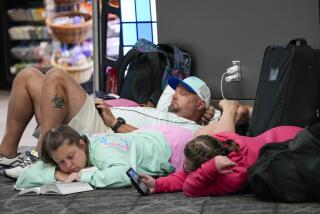Air Service: What Now?
- Share via
Ten years after airline deregulation, the circle has virtually been closed. The big lines no longer are bothered by eager fare-cutting newcomers like People Express that seemed to sprout almost overnight. Fares are inching upward, and are likely to continue in that direction. Many of the successful regional carriers like Western, Air Cal, PSA, Republic, Frontier and Ozark have been absorbed. The five major domestic lines now carry more than 70% of airline traffic--a greater concentration of business than before deregulation. Some lines have a lock on critical hub airports--a situation now being reflected in fares.
A single airline handles more than half the passengers boarding at 18 major airports, including TWA in St. Louis and Northwest at Minneapolis-St. Paul. Further, the most successful big lines like American and United have insulated themselves against competition with sophisticated computer reservation systems linking them to travel agents and through which the lines can quickly match fare changes of their competitors. There is talk of even more consolidation.
What now? Has the promise of deregulation failed? Not in some ways. The surviving lines are stronger economically and in a better position to modernize their aging fleets with safer and more efficient planes. Chronic delays and passenger complaints have fallen in the past two years. Affiliation of commuter lines with the giant companies has improved service to many isolated cities and towns, although often at exorbitant fares. Airline labor strife is declining along with fears about safety. The lines seem to be paying more attention to service.
There certainly is cause for concern with the consolidation of business in a handful of large airlines and the sudden abandonment of many of the bargain fares that lured so many new air travelers during deregulation. Airports are jammed: Much of the merger mania involved a scramble for coveted terminal gates. The lack of available gate space makes it doubly difficult for any new competitors to join the fray. An antiquated air-traffic-control system still puts a limit on flights in and out of the busiest airports at critical times of the day. As lines try to keep as many planes in the air as possible, there is increasing concern about the airworthiness of older planes, some of which have been flying for more than 20 years.
Congress and the new Administration can help by freeing the airport trust fund so that long-overdue airport construction and expansion can proceed. The modernization of air-traffic control must go forward so that more flights can be scheduled safely. The Justice Department must take a sharply critical look at any more airline mergers that would reduce competition. The government must closely monitor fares to make certain that the public is not victimized by de facto price-fixing.
Competition is the only vehicle that keeps pricing proper, one former airline official said. That is the yardstick by which deregulation must be judged.
More to Read
Sign up for The Wild
We’ll help you find the best places to hike, bike and run, as well as the perfect silent spots for meditation and yoga.
You may occasionally receive promotional content from the Los Angeles Times.






